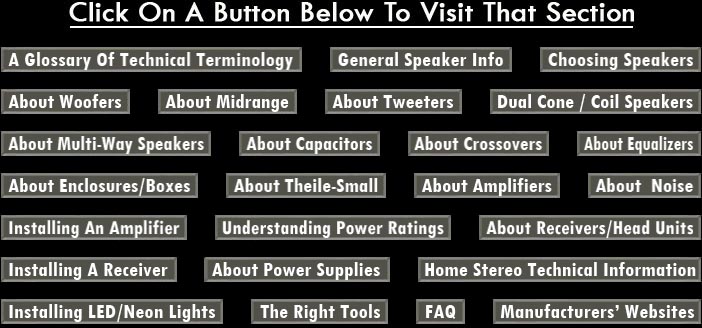


Pad
An electrical circuit used to attenuate or reduce the amplitude of an audio signal by a fixed amount, e.g a -15dB pad reduces the signal by a fixed 15 decibels.
Pan Pot
Short for panoramic potentiometer, this is a knob controlling a voltage divider that can send a signal to a combination of two busses, such as left and right. Always found on mixing consoles to set up (pan) a signal within the stereo field, it is also called a 'balance' control on domestic stereo amplifiers.
Parallel Wiring
A circuit in which two or more devices are connected to the same source of voltage, sharing a common positive and negative point, so that each device receives the full applied voltage.
Parametric Equalizer
A multi-band equalizer enabeling control of at least three essential "parameters" of the internal bandpass filter sections. These parameters being: amplitude, center frequency and bandwidth. This allows the user to not only control the amplitude of each band, but also to shift the center frequency and to widen or narrow the width or coverage of the affected section of the aural spectrum. Regulation is done by either rotary and slide controls. Other types of parametric equalizers exist which allow control of center frequency, but not bandwidth. For rotary control units, the most common term is quasi-parametric. For units with slide controls the popular term is paragraphic. The frequency control may be continuously variable or switch selectable in steps. Cut-only parametric equalizers (with adjustable bandwidth or not) are called notch equalizers, or band-reject equalizers.
Passive Radiator
Sometimes known as a "drone cone," these passive devices respond to internal pressure within the speaker and react to it to produce reinforcing emissions to extend the output of the lower frequencies below the resonance point of the active woofer. They may look like Drivers but they lack an active motor assembly.
Passive Component
In a crossover system, a non-powered component used to separate an audio signal into a specified frequency band before it goes to a particular amplifier or driver. A passive device usually incurs some loss (expressed in decibels) to a system. Typical such components include capacitors, coils, and resistors.
Peak Power Handling (MAX)
Peak power handling refers to the amount of power a speaker is estimated to handle during a brief high-intensity musical burst. Since this can vary with both frequency and amplitude, it is a much less accurate way to judge speaker durability and performance than RMS (see RMS).
Period
The amount of time required to complete a full single cycle of a sound wave.
Permalloy Tape Head
A cassette tape head constructed of permalloy, an alloy made primarily of nickel and iron, used for its superior high wear resistance and permeability, offering superior frequency response at a low cost.
Phase
The relative timing of a sound wave that is measured in degrees from 0 to 360.
Phase Cancellation
Audio signals are complex phenomena expressed mathematically as phasors, or vectors. When two signals have the same exact time relationship to each other, they are said to be "in-phase;" if they do not, they are said to be "out-of-phase." If the energy of two out-of-phase signals are combined, they will, in fact, subtract from one another. This is called phase cancellation. Another type of phase cancellation can be seen when water waves interact. One wave's energy becomes stronger when two waves collide in-phase (summing) and becomes weaker when they collide out-of-phase. Air (barometric) fronts act in the same way.
Phase Delay
A phase-shifted sine wave appears displaced in time from the input waveform. This displacement is called phase delay.
Phase Linear
Any audio system which accurately preserves phase relationships between frequencies, i.e., that exhibits pure delay.
Phase Shift
The fraction of a complete cycle elapsed as measured from a specified reference point and expressed as an angle. 2. Out of phase in an un-synchronized or un-correlated way.
Phon
A unit of apparent loudness, equal in quantum to the intensity in decibels of a 1,000 Hz tone estimated to be as loud as the sound being measured.
Piezo (Tweeter)
A tweeter whose motor is simply a crystal of Piezo material through which the signal current flows. The crystal lattice responds to this by bending in proportion to the Amplitude and frequency of the incoming signal. Because it is a high impedance device, it does not need a Crossover in line with the source. Piezo tweeters are very efficient Drivers and are relatively inexpensive. They come in a large variety of designs and radiators.
Piezoelectric Driver
This is among the most robust and least expensive alternative drivers for the high frequency reproduction. The material used in the Piezoelectric Driver is a piezoelectric polymer first developed in the early 1960's. This piezoelectric polymer is a plastic-like material that, unlike a crystal, can be made into thin sheets and fashioned into a great variety of shapes. Its transient and high frequency response is very good because the moving mass is negligible. The driver operates by bending the lattices in the crystalline structure of the piezoelectric polymer film. The Piezoelectric Driver is inappropriate for low frequency applications, as it is incapable of large air displacements. This high frequency transducer is very uniform in response from approximately 2 kHz to 20 kHz. It typically is used in many car stereo enclosures and other compact space environments.
Pink Noise
Pink noise is a random noise source characterized by a flat amplitude response per octave band of frequency, i.e., it has equal energy, or constant power, per octave. Pink noise is created by passing white noise through a filter having a 3 dB/octave roll-off rate. Due to this roll-off, pink noise sounds less bright and richer in low frequencies than white noise. Since pink noise has the same energy in each 1/3-octave band, it is the preferred sound source for many acoustical measurements in respect to the critical band concept of human hearing. The name comes from the filtering of white noise. White noise is analogous to white light in that it contains all audible frequencies distributed uniformly throughout the spectrum. Passing white light through a prism (a form of filter) breaks it down into a range of colors. Examination shows that red light is characterized by the longer wavelengths of light, i.e., light in the lower frequency region. Similarly, pink noise has higher energy in the low frequencies, hence the term, pink.
Pitch
The subjective sensation produced by various frequencies. The higher the frequency, the higher the perceived pitch; however, frequency is not linearly related to pitch. See also 'Concert Pitch'.
Polar response
A plot of the Amplitude measurement of a speaker's output at a given frequency relative to an off-axis angle. In other words, the difference that exists between how a speaker sounds when being heard directly in front, compared to how it sounds while standing off to one side. (See Dispersion)
Pole Piece
The ends or "Poles" of a magnet from which the magnetic lines of force, measured in Gauss, are at the greatest strength. In a typical speaker, this will be at the gap within which the voice coil is located. (see Bumped & Vented)
Polycarbonate
A polymer based plastic material offering superior resistance against resonance.
Polypropylene
A plastic based material used primarily for speaker cones due to its rigidity, damping and resistance against harsh environmental conditions.
Port
An opening, usually a tube, in an enclosure, through which sound is permitted to pass.
Port Diameter
The measurement across the port opening. Measured as internal diameter (not outer diameter .
Port Length
The measurement of the length of the port tube.
Ported (enclosure)
Any enclosure design with ports. In such designs the internal pressure wave is processed to be used either solely, or in conjunction with the woofer front wave in order to produce sound. A port can be a simple opening, a tube or a Passive Radiator.
Potentiometer
A three-terminal variable resistor. Two terminals connect to the ends of a flat resistor, while the third terminal is attached to a moveable contact that interfaces with the resistive element. The moveable terminal, or slider, is capable of being positioned from one end of the element to the other. There are many physical types, with the rotary design being the most common, followed by linear slider used in graphic equalizers, for example. Often used as voltage dividers in electronic circuits, the input voltage is applied to the top of the resistive element, while the other end is tied to ground or a common reference and the output is taken from the slider. When the slider is positioned to the top extreme, the output equals the input less of course, the effect of the resistor, moving it to the bottom extreme gives an output of zero volts; and every possible level between is available as the slider is moved from one end to the other. The most commonly encountered application of this arrangement to control the volume of an audio device. In this way the electrical potential is varied, hence, a potentionmeter. The rate at which the voltage changes as the slider is moved is controlled by the taper of the pot. The taper defines the amount of resistive change as a function of travel. Several popular examples are listed below:
- audio taper (aka A-taper): Usually 15% resistance at the 50% rotation point.
-
linear taper (aka B-taper): Always 50% resistance at the 50% travel point
- log taper: Often used an an audio taper since its 50% rotation point has 10% resistance
- MN taper (" balance control") Special taper developed for home stereo. Consists of two sections (one for each channel) operating opposite each other. Exactly one-half of each section is a zero resistance surface (i.e., solid-copper or equivalent), the next 50% of travel is linear taper. Therefore for one channel rotating the slider through the first 50% of travel does not change the level at all, while the other channel is reduced from full to zero, and vice-versa, with the middle position (usually featuring a center-detent) always passing full signal to each channel.
Power
a. The product of applied voltage (potential difference) and current in a direct-current circuit (or the voltage squared divided by the resistance, or the current squared times the resistance). b. The product of the effective values of the voltage and current with the cosine of the phase angle (between current and voltage) in an alternating-current circuit. c.Power The amount of energy (in joules) that a device delivers or consumes divided by the time (in seconds) that the device is operating. See: apparent power and rms power.
Power factor
The ratio of the total power in watts (resistive load) to the total apparent power in voltamperes (VA) (reactive load). The difference between watts and VA is due to reactive load impedance. Apparent power equals watts only for a purely resistive load (i.e., zero degrees phase shift between the applied voltage and the resultant current). Power factor is best thought of intuitively as the multiplier (ranging between 0 and 1) that you must use to obtain the real power from the apparent power. For example if the rms voltage and current of a circuit is measured and multiplied together, the apparent power is obtained, but this value must be multiplied by the power factor to obtain the real power. If the load is purely resistive then the phase difference between the voltage and current will be zero and the power factor will be one, and the apparent power will equal the true power -- but only for a resistive load. For a reactive load (any load with inductive and/or capacitive reactance, i.e., any real world load) there will be a phase difference between the voltage and the current due to the phase delay introduced by the reactive elements. Simply put, since the maximum voltage and current do not occur at the same instant of time the amount of power developed is less than the measured rms voltage and current multiplied together.
Power Handling (continuous or RMS)
A rating of a Driver's ability in optimum conditions to handle a specified amount of audio power (electrical current power) on a constant basis, without damage. This is generally considered to be a conservative and reliable figure to use in judging what types of amplifier power will be most successful with a particular speaker design.
Pre-Amp
A circuit unit which takes a small signal and amplifies it sufficiently to be fed into the power amplifier for further amplification. A pre-amp includes all of the controls for regulating tone, volume, and channel balance.2
Preamp Output
Typically found on headunits, a preamp output provides low level, high quality audio signal for use with external amplifiers.
Precedence Effect
Also known as the Haas effect, this phenomenon identifies the tendency for the ear to attribute all perceived sound to the nearest emitter, even if a more distant speaker is actually louder. Thus, drums that yield 90 percent or more of their energy in the non-directional lower frequencies are perceived as located in the space created by the tiny amount of higher frequency overtones. It is also for this reason that sounds from the rear speakers of a surround system are delayed by 10 to 30 milliseconds, so that they can be experienced as coming from the rear direction.
Preset
A collection of system settings stored in a memory that is virtually instantly recallable, typically at the touch of a button.
Program Bank
A Custom File feature that allows the user to flag the tracks on a disc, indicating whether they should be played or skipped.
Program Play
A Custom File feature that allows the user to define a sequence of 12 tracks, in a specific order, for customized playback. Up to two banks of 12 track sequences can be recalled, for up to 24 tracks total.
Proximity Effect
An increase in the bass response of some microphones as the distance between the mike and its sound source is decreased.
Psychoacoustics
The scientific study of the relationship between human hearing and its stimulus; in other words, how we hear.
Punch
Like "hitting hard," a subjective colloquial term that describes the snap or deep impact of the low end response of an audio system.















